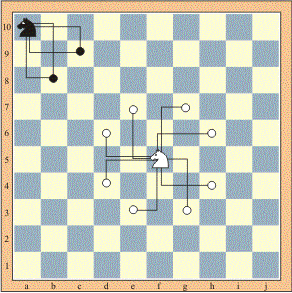The Queen can be moved straight-lined from it's position to any reachable position, vertically, horizontally or diagonally. It can therefore be moved in one of eight directions and be put on one of 35 fields.
The King moves to any adjoining field, vertically, horizontally or diagonally.
The opponents have to move pieces according to the rules, which determine the moves of each piece. With the exception of castling, a move is the transfer by a player of one of his pieces from one square to another square.
Movements can only be performed on the empty fields. If there are many pieces on the chessboard, then the movements can be restricted. It means that pieces of one player (white or black) can't be played on the field occupied by the piece of the same player. The piece can move to the nearest field behind another piece (observing toward the direction of the movement).
The Knight and the Civilian may cross the square occupied by another piece.
The movement of the King is especially restricted; the King can't be moved to any of the fields, attacked by the opponents piece.
The Knight has a special form of movements; a jump, which is shaped in a form of a letter "L" (straight or mirrored). This movement is composed of two different steps; first, it makes one step of one single square along its rank or file, and then, still moving away from the square of departure, one step of one single square on a diagonal. This way it can jump over the other pieces, black and white. The Knight can reach 8 fields.
The Rook can be moved to any field horizontally or vertically, so it can reach any field on the file or the rank, on which it stands.
The Bishop can only move on the diagonals, black or white. It can reach 17 fields.
If a Pawn moves from it's original position two or three fields forward, so that its new position lies beside or one field behind the opponents pawn, then the opponent has the right to make a capture, but only if he does it immediately after the move was made. Opponent can make a capture in the way as if the player's pawn was moved one or two fields forward. This way of making a capture is called En Passant. If the En Passant isn't used immediately, it can't be used latter in the game.
Next: page 4
Written by Redzo Kolakovic.







